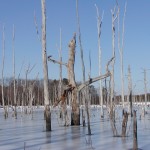A Unique Opportunity
Manasquan Reservoir Osprey nest repairs
by Ben Wurst, Habitat Program Manager

On January 17th I was forwarded a message from fellow osprey conservationist and colleague Jon Rosky. Jon has been helping provide nesting structures for ospreys since the early 90s with his Osprey Recovery Project. Tanya Dinova, a naturalist/interpreter at the Manasquan Reservoir Environmental Center contacted Jon to get assistance with a snag (a dead standing tree) that held an osprey nest since 2008 on the reservoir. This past October a storm caused the snag to snap and the nest was lost.
Luckily this occurred during the non-breeding season, otherwise the nestlings would not have survived. Tanya reported that the nest produced 2 young in 2010 and 2 in 2009. Great results for a natural nest that is directly over water! One might argue to not do anything and allow ospreys to find another snag to build a nest on. There are multiple snags in the water that could provide another natural nest site. If we were not going to do anything then this would be the likely outcome. However, many of the snags are not large enough to hold an osprey nest and there is a good chance the nest could fall during the breeding season.
Ospreys return to the same nest site year after year. And young adults return to where they originated to reproduce when they are 3 years old. Ospreys usually live till around 10 years old in the wild. The oldest osprey that was ever encountered in New Jersey was a female that was 18 years old. She sustained injuries from a close encounter with an eagle near Avalon several years ago and did not survive.

In her message Tanya stressed the importance of having ospreys that nest on the reservoir as an educational resource to visitors of the park. A total of 3 pairs of ospreys nest on the reservoir. Naturalists, like Tanya, educate the public about ospreys, their decline, their importance in the ecosystem, and their return to historic numbers in New Jersey. This is a very important part of the recovery of ospreys in New Jersey and it will help foster awareness for them in the future.
Monmouth County has been an area of interest to me. Since I began working with ospreys in 2004 there were only a few nests in Monmouth County that were monitored. In 2010 there were 14 active nests (not including those on Sandy Hook and the Raritan Bay) where nesting observations were made. These observations help us determine the health of the local and state populations. In 2010, productivity averaged 1.86 young/active (known-outcome) nest. It was recorded at 1.25 in 2009. The population is continuing to grow in Monmouth County and with only limited areas to nest, ospreys are nesting in peculiar locations.
Many ospreys are choosing to nest on cell towers, boat lifts, and other tall structures. Because of habitat loss these are the only a few structures that are available to them. Manasquan Reservoir is an exception. When the dam was installed it killed trees when the water levels rose. This created new nest sites for ospreys from the snags that were left. However, today many snags are beginning to decay and osprey nesting sites are lost.
This situation has created a unique opportunity to collaborate and find a solution. I suggested that instead of installing a new nesting platform, to install a box-top (3×3′ wood box) on top of the snag. The box would allow the ospreys to nest in the same tree and it would provide added stability ospreys rely on to incubate eggs and raise young. We will perform this delicate task before ospreys return in mid-March.
Discover more from Conserve Wildlife Foundation of NJ
Subscribe to get the latest posts sent to your email.